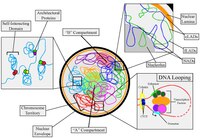
Photo from wikipedia
Hepatitis B virus (HBV) infection is of global importance with over 2 billion people exposed to the virus during their lifetime and at risk of progressive liver disease, cirrhosis and… Click to show full abstract
Hepatitis B virus (HBV) infection is of global importance with over 2 billion people exposed to the virus during their lifetime and at risk of progressive liver disease, cirrhosis and hepatocellular carcinoma. HBV is a member of the Hepadnaviridae family that replicates via episomal copies of a covalently closed circular DNA (cccDNA) genome. The chromatinization of this small viral genome, with overlapping open reading frames and regulatory elements, suggests an important role for epigenetic pathways to regulate viral transcription. The chromatin‐organising transcriptional insulator protein, CCCTC‐binding factor (CTCF), has been reported to regulate transcription in a diverse range of viruses. We identified two conserved CTCF binding sites in the HBV genome within enhancer I and chromatin immunoprecipitation (ChIP) analysis demonstrated an enrichment of CTCF binding to integrated or episomal copies of the viral genome. siRNA knock‐down of CTCF results in a significant increase in pre‐genomic RNA levels in de novo infected HepG2 cells and those supporting episomal HBV DNA replication. Furthermore, mutation of these sites in HBV DNA minicircles abrogated CTCF binding and increased pre‐genomic RNA levels, providing evidence of a direct role for CTCF in repressing HBV transcription.
Journal Title: Cellular microbiology
Year Published: 2020
Link to full text (if available)
Share on Social Media: Sign Up to like & get
recommendations!